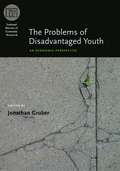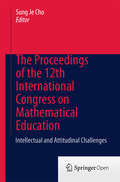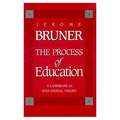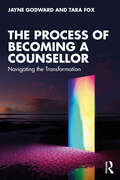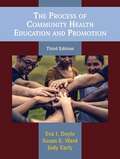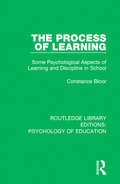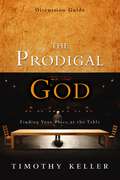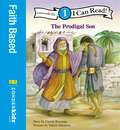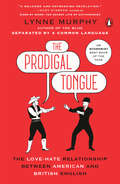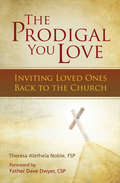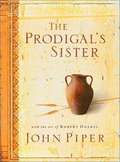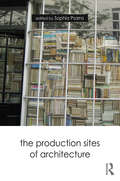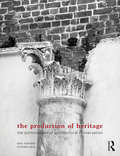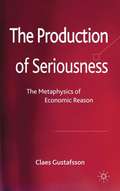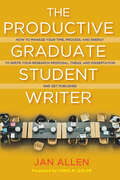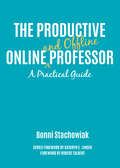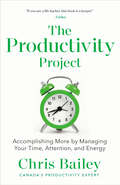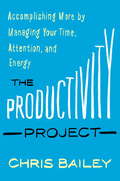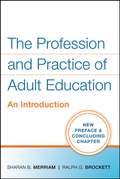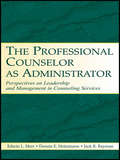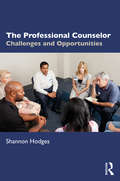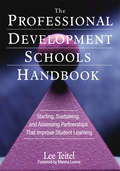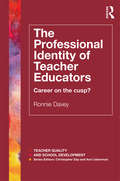- Table View
- List View
The Problems of Disadvantaged Youth: An Economic Perspective
by Jonathan GruberOne of the most important public policy issues in the United States is how to improve the life prospects of disadvantaged youth who, in their formative years, face low-quality school systems, poor access to health care, and high-crime environments. The Problems of Disadvantaged Youth includes a broad range of research examining various aspects of disadvantage, and ways of increasing the ability of low-income youths to improve their circumstances later in life. Taking an empirical economics perspective, the nine essays in this volume assess the causal impacts of disadvantage on youth outcomes, and how policy interventions can alleviate those impacts. Each chapter develops a framework to describe the relationship between youths and later life outcomes, addressing such factors as educational opportunity, health, neighborhood crime rates, and employment. This vital book documents the serious short- and long-term negative consequences of childhood disadvantage and provides nuanced evidence of the impact of public policy designed to help needy children.
The Proceedings of the 12th International Congress on Mathematical Education
by Sung Je ChoThis book comprises the Proceedings of the 12th International Congress on Mathematical Education (ICME-12), which was held at COEX in Seoul, Korea, from July 8th to 15th, 2012. ICME-12 brought together 3500 experts from 92 countries, working to understand all of the intellectual and attitudinal challenges in the subject of mathematics education as a multidisciplinary research and practice. This work aims to serve as a platform for deeper, more sensitive and more collaborative involvement of all major contributors towards educational improvement and in research on the nature of teaching and learning in mathematics education. It introduces the major activities of ICME-12 which have successfully contributed to the sustainable development of mathematics education across the world. The program provides food for thought and inspiration for practice for everyone with an interest in mathematics education and makes an essential reference for teacher educators, curriculum developers and researchers in mathematics education. The work includes the texts of the four plenary lectures and three plenary panels and reports of three survey groups, five National presentations, the abstracts of fifty one Regular lectures, reports of thirty seven Topic Study Groups and seventeen Discussion Groups.
The Process Of Education
by Jerome S. BrunerIn this classic argument for curriculum reform in early education, Jerome Bruner shows that the basic concepts of science and the humanities can be grasped intuitively at a very early age. He argues persuasively that curricula should he designed to foster such early intuitions and then build on them in increasingly formal and abstract ways as education progresses. Bruner’s foundational case for the spiral curriculum has influenced a generation of educators and will continue to be a source of insight into the goals and methods of the educational process.
The Process of Becoming a Counsellor: Navigating the Transformation
by Jayne Godward Tara FoxThis book aims to help the reader understand what is involved in becoming a counsellor, and what to expect of the experience of counsellor training.Covering everything from interviewing for practitioner training, doing personal and professional development, to seeing your very first client, this book gives a thorough, step-by-step examination of the process of becoming a counsellor. It draws upon the authors’ diverse experience of working within the counselling field, academic research and personal testimonies from a wide range of counselling students. Readers will gain valuable insight into the personal demands/responsibilities and the transformation that training and qualifying involves. Included throughout the book are pedagogical features such as reflection points, vignettes, case studies, and activities which will help prepare readers for the experiential process they will go through.The Process of Becoming a Counsellor is an important resource for anyone planning to start or just beginning counselling training. It is a must-read for anyone contemplating a counselling qualification or who may be wondering if training to be a counsellor is the right pathway for them.
The Process of Community Health Education and Promotion
by Jody Early Eva I. Doyle Susan E. WardHealth education promotes lifestyles and environments that enhance health, wellness, and quality of life for individuals and communities. This goal serves as the cornerstone of The Process of Community Health Education and Promotion, Third Edition. The authors provide readers a comprehensive introduction to the information, perspectives, and competencies they will need to successfully promote health in community, school, workplace, and health care settings. Rooted in an inter-professional paradigm, the importance of collaborative partnerships is explored throughout the text. <p><p>The latest edition sparks critical thinking, discussion, and action by including real-world examples and engaging questions. A strong emphasis on social determinants and their influence shapes the updated section on health equity, which ends with a discussion on essential elements for promoting this universal human right. Special features highlighted throughout this action-oriented book showcase the authors' experiential learning approach. "For Your Information" boxes complement and expand on chapter content. "For Your Application" prompts provide a variety of self-directed or instructor-guided activities. Additionally, appendices include a community assessment project guide and a professional e-portfolio guide, to which many of the activities in the book build toward.
The Process of Learning: Some Psychological Aspects of Learning and Discipline in School (Routledge Library Editions: Psychology of Education)
by Constance BloorOriginally published in 1930, this book was designed to meet the needs of students in Training Colleges. It is the outcome of first-hand experience of the difficulties encountered by students in the subject of educational theory and its application to the problems of the classroom at the time. It was the hope of the writer that this book may help the student to find a profitable connection between the theory of the lecture room and the problems of the school classroom.
The Prodigal God Discussion Guide: Finding Your Place at the Table
by Timothy KellerTwo sons, one who kept the rules religiously and one who broke them all. One Father who loved both lost sons beyond anything they could imagine. Discover how deep and far God's grace goes in The Prodigal God The Prodigal God discussion guide will help you uncover, personalize, and apply life-changing insights from The Prodigal God DVD and book. In six captivating sessions, pastor and New York Times bestselling author Timothy Keller opens your eyes to the powerful message of Jesus' best-known—and least understood—parable. The Prodigal God is a revelation of the very heart of the gospel: God's radical love for sinners of every kind. Taking you beyond the traditional focus on the wayward younger son, Keller helps you glean insights from each of the characters in Jesus' parable: the irreligious younger son, the moralistic elder son, and the Father who lavishes his love on both. Inside this guide, you'll explore questions for group discussion and personal reflection, and exercises that will help you experience the truths of Jesus' parable in your own life. The gospel is neither religion nor irreligion, but something else entirely. Whether you're a devout believer or a skeptic, The Prodigal God will challenge you to see Christianity in a whole new way. Session titles include the following: The Parable The People Around Jesus The Two Lost Sons The Elder Brother The True Elder Brother The Feast of the Father Designed for use with The Prodigal God DVD and book.
The Prodigal God: Recovering the Heart of the Christian Faith
by Timothy KellerKeller uses one of the best-known Christian parables to reveal an unexpected message of hope and salvation. He also covers such topics as why some people profess Christianity, but are disenchanted with the church. He clarifies the debate about faith and works.
The Prodigal Son
by David Hately"This story about the father and his two sons was first told by Jesus." It is retold by David Hately and illustrated by Helen Drabble in order to make it understandable for young children from the ages of five to seven. The story is as follows: A father has two sons who he loves equally. He explains to them that he plans to give them an equal share of his wealth one day in the future. However, his younger son wants his share immediately so that he can leave his father and enjoy himself. On the other hand, the older son does not want to receive his share early but decides to stay at home and help his father take care of the land. The story of "The Prodigal Son" centers around what happens to these two sons and how their father relates to them. At the end of the book, the author writes a short note explaining how this story shows our relationship with God today.
The Prodigal Son: Level 1 (I Can Read! #Level 1)
by Crystal BowmanChristian parents especially appreciate books for their young readers that help them understand more about God. Reading the Bible can be a very overwhelming challenge for young readers. Therefore, Bible stories written in a learn-to-read format are a welcomed product. This is the idea behind the proposal Bible Stories for I Can Read! Level1. When interesting stories from the Bible are written with on-level vocabulary, the child gains knowledge of Scripture and biblical truths while developing his or her reading skills. The result is a meaningful and positive reading experience for the child.
The Prodigal Tongue: The Love-Hate Relationship Between American and British English
by Lynne MurphyAn American linguist teaching in England explores the sibling rivalry between British and American English “English accents are the sexiest.” “Americans have ruined the English language.” Such claims about the English language are often repeated but rarely examined. Professor Lynne Murphy is on the linguistic front line. In The Prodigal Tongue she explores the fiction and reality of the special relationship between British and American English. By examining the causes and symptoms of American Verbal Inferiority Complex and its flipside, British Verbal Superiority Complex, Murphy unravels the prejudices, stereotypes and insecurities that shape our attitudes to our own language. With great humo(u)r and new insights, Lynne Murphy looks at the social, political and linguistic forces that have driven American and British English in different directions: how Americans got from centre to center, why British accents are growing away from American ones, and what different things we mean when we say estate, frown, or middle class. Is anyone winning this war of the words? Will Yanks and Brits ever really understand each other?
The Prodigal You Love: Inviting Loved Ones Back to the Church
by Theresa Aletheia Noble FSP Father Dave Dwyer CSPUsing the Parable of the Prodigal Son, Sr. Theresa Noble, a formerly fallen-away Catholic, gently covers the necessary elements of approaching those who have left the Church. She encourages you to meet them where they are while emphasizing the importance of the faith. With her gentle encouragement, she will lead you to continue to hope for their conversion, so that you might share the joy of the Father when The Prodigal You Love returns home.
The Prodigal's Sister
by John PiperThe Grace of God is so astonishing that we cannot adequately describe it. But Jesus knew how to say it in a parable. With the drawings of Robert Doares depicting the setting, The Prodigal's Sister poetically and imaginatively retells the parable of the prodigal son with a startling twist. In the poem the younger sister of the prodigal sets out to reclaim her brother's life. The new life the prodigal finds in his father's love is mirrored in the mercy the legalistic elder brother finds when he learns that his slave-like labor is useless in winning his father's love. The Prodigal's Sister, which the author reads on the accompanying CD, rejoices over the incomparable grace of God. For anyone who has ever felt beyond the hope of joy, this poem opens a way home to the Father.
The Production Sites of Architecture
by Sophia PsarraThe Production Sites of Architecture examines the intimate link between material sites and meaning. It explores questions such as: how do spatial configurations produce meaning? What are alternative modes of knowledge production? How do these change our understanding of architectural knowledge? Featuring essays from an international range of scholars, the book accepts that everything about the production of architecture has social significance. It focuses on two areas: firstly, relationships of spatial configuration, form, order and classification; secondly, the interaction of architecture and these notions with other areas of knowledge, such as literature, inscriptions, interpretations, and theories of classification, ordering and invention. Moving beyond perspectives which divide architecture into either an aesthetic or practical art, the authors show how buildings are informed by intersections between site and content, space and idea, thought and materiality, architecture and imagination. Presenting illustrated case studies of works by architects and artists including Amale Andraos, Dan Wood, OMA, Koen Deprez and John Soane, The Production Sites of Architecture makes a major contribution to our understanding of architectural theory.
The Production of Heritage: The Politicisation of Architectural Conservation
by Alan Chandler Michela PaceIn this important book, the authors unpack the theoretical and practical issues around the development of heritage sites, critically dissecting key conservation benchmarks such as the ICOMOS guidelines, BS 7913 and the RIBA Conservation Plan of Work to reveal the mechanics of heritage guidance, its advantages and conceptual limitations. Underpinned by an active understanding of the conservation philosophy of William Morris, the book presents five case studies from the UK and North and South America that speak about different facets of heritage value, such as urban identity, commodification, authenticity, materiality and heritage as an intellectual and ethical framework. Heritage is never neutral; its definition is privileged yet its influence is political. Art, landscape and archaeology all offer examples of how the operational ideas of adjacent disciplines can influence an integrated idea of heritage conservation, and how this is communicated in order to determine significance and share in its custodianship. This book provides insights into how to identify and challenge these limitations, expanding inclusion by describing tactics for changing how people can relate to and build on the past. Clearly written for all levels of readership within the conservation professions and community custodians of heritage buildings and places, the book provides strategies and tactics for understanding the heritage significance of materials, their fabrication, detail and use. The narratives that historic fabric contains can help shape the meaningful involvement of local people, providing a roadmap for those navigating the double-bind of using the past to underpin the future.
The Production of Seriousness
by Claes GustafssonThis book is about the roots of managerial rationality. A theoretical base, founded on the concept of 'memetics' is developed in order to explain human thinking and human reason as products of cultural evolution. Cultural change and development are explained by simple, value-driven memetic mechanisms like 'ritualization' and 'extremization'.
The Productive Graduate Student Writer: How to Manage Your Time, Process, and Energy to Write Your Research Proposal, Thesis, and Dissertation and Get Published
by Jan E. AllenThis book is for graduate students--and others--who want to become more productive writers. It's especially written for those who want to:• increase their motivation, focus, and persistence to move a project to completion• overcome procrastination and perfectionistic tendencies• reduce (or write in spite of) their anxiety and fear of writing• manage their time, work, energy (and advisor) for greater productivityThe process or craft of sustained writing is not a matter that’s taught to undergraduate or graduate students as part of their studies, leaving most at sea about how to start a practice that is central to a career in academe and vital in many other professional occupations.This book grew out of conversations Jan Allen has held with her graduate students for over 30 years and reflects the fruit of the writing workshops and boot camps she has conducted at three universities, her own and numerous colleagues’ experiences with writing and advising, as well as the feedback she receives from her popular Productive Writer listserv.While Jan Allen recognizes that writing is not an innate talent for most of us, she demonstrates that it is a process based on skills which we can identify, learn, practice and refine. She focuses both on the process and habits of writing as well as on helping you uncover what kind of writer are you, and reflect on your challenges and successes. With a light touch and an engaging sense of humor, she proposes strategies to overcome procrastination and distractions, and build a writing practice to enable you to become a more productive and prolific writer.Jan Allen proposes that you read one of her succinct chapters – each devoted to a specific strategy or writing challenge – each day, or once a week. When you find one that increases your concentration, motivation or endurance, make it a habit. Try it for two weeks, charting the resulting increased productivity. It will become part of your repertoire of writing and productivity tools to which you can progressively add.
The Productive Online and Offline Professor: A Practical Guide
by Bonni StachowiakWhat does it mean to be a productive professor in higher education? What would it feel like to have more peace and productivity? To have nothing fall through the cracks? The Productive Online and Offline Professor is written for today’s busy higher education professional. Through an exploration of what it means to make work meaningful, this book offers practical strategies and tips to support higher education professionals in efficiently managing and effectively using a wide range of technologies and productivity tools.Higher education instructors will find this guide helps them to fulfill their teaching roles with excellence and to build engaging relationships with students while also successfully managing other priorities in their professional and personal lives.The Productive Online and Offline Professor assists those who teach online and blended courses with managing their personal productivity. Faculty are often expected to provide support and feedback to learners outside of normal work hours in non traditional classes. Programs that are designed with more asynchronous content may cause faculty to perceive that it is difficult to ever press the “off button” on their teaching. The author offers guidance and suggests software tools for streamlining communication and productivity that enable faculty to better balance their lives while giving rich feedback to students.Part 1 addresses the challenges in defining productivity and presents a working definition for the text.Part 2 describes the ability to communicate using both synchronous and asynchronous methods, along with ways of enriching such communication.Part 3 describes methods for finding, curating, and sharing relevant knowledge both within one’s courses and to a broader personal learning network (PLN).Part 4 examines specific tools for navigating the unique challenges of productivity while teaching online. It includes ways to grade more productively while still providing rich feedback to students.Part 5 shares techniques for keeping one’s course materials current and relevant in the most efficient ways possible.The Productive Online and Offline Professor is a practical guide for how to provide high quality online classes to diverse students. This book shares specific technology and other tools that may be used in charting a course toward greater productivity. It is intended to be a professional resource for fulfilling our roles with excellence and joy, while managing other priorities in our personal and professional lives.
The Productivity Project
by Chris BaileyA fresh, personal, and entertaining exploration of a topic that concerns all of us: how to be more productive at work and in every facet of our lives. Chris Bailey turned down lucrative job offers to pursue a lifelong dream--to spend a year performing a deep dive experiment into the pursuit of productivity, a subject he had been enamored with since he was a teenager. After obtaining his business degree, he created a blog to chronicle a year-long series of productivity experiments he conducted on himself, where he also continued his research and interviews with some of the world's foremost experts, from Charles Duhigg to David Allen. Among the experiments that he tackled: Bailey went several weeks with getting by on little to no sleep; he cut out caffeine and sugar; he lived in total isolation for 10 days; he used his smartphone for just an hour a day for three months; he gained ten pounds of muscle mass; he stretched his work week to 90 hours; a late riser, he got up a 5:30 every morning for three months--all the while monitoring the impact of his experiments on the quality and quantity of his work. The Productivity Project--and the lessons Chris learned--are the result of that year-long journey. Among the counterintuitive insights Chris Bailey will teach you: · slowing down to work more deliberately;· shrinking or eliminating the unimportant; · the rule of three; · striving for imperfection; · scheduling less time for important tasks; · the 20 second rule to distract yourself from the inevitable distractions; · and the concept of productive procrastination.In an eye-opening and thoroughly engaging read, Bailey offers a treasure trove of insights and over 25 best practices that will help you accomplish more.From the Hardcover edition.
The Productivity Project: Accomplishing More by Managing Your Time, Attention, and Energy
by Chris BaileyA fresh, personal, and entertaining exploration of a topic that concerns all of us: how to be more productive at work and in every facet of our lives. Chris Bailey turned down lucrative job offers to pursue a lifelong dream--to spend a year performing a deep dive experiment into the pursuit of productivity, a subject he had been enamored with since he was a teenager. After obtaining his business degree, he created a blog to chronicle a year-long series of productivity experiments he conducted on himself, where he also continued his research and interviews with some of the world's foremost experts, from Charles Duhigg to David Allen. Among the experiments that he tackled: Bailey went several weeks with getting by on little to no sleep; he cut out caffeine and sugar; he lived in total isolation for 10 days; he used his smartphone for just an hour a day for three months; he gained ten pounds of muscle mass; he stretched his work week to 90 hours; a late riser, he got up at 5:30 every morning for three months--all the while monitoring the impact of his experiments on the quality and quantity of his work. The Productivity Project--and the lessons Chris learned--are the result of that year-long journey. Among the counterintuitive insights Chris Bailey will teach you: · slowing down to work more deliberately; · shrinking or eliminating the unimportant; · the rule of three; · striving for imperfection; · scheduling less time for important tasks; · the 20 second rule to distract yourself from the inevitable distractions; · and the concept of productive procrastination. In an eye-opening and thoroughly engaging read, Bailey offers a treasure trove of insights and over 25 best practices that will help you accomplish more.From the Hardcover edition.
The Profession and Practice of Adult Education
by Sharan B. Merriam Ralph G. BrockettThe Profession and Practice of Adult Education is a timely book and an excellent introduction to the field. Drawing from an extensive volume of literature, it provides comprehensive coverage and a clear guide. Graduate students will benefit from it and practitioners will be kept abreast of changes that are occurring.--Peter Jarvis, professor of continuing education and senior research professor, University of Surrey, United Kingdom
The Professional Counselor as Administrator: Perspectives on Leadership and Management of Counseling Services Across Settings
by Edwin L. Herr Dennis E. Heitzmann Jack R. RaymanA largely undiscussed problem exists in the counseling community. Each year many excellent professional counselors with little or no administrative preparation or leadership experience are asked to assume administrative roles in schools, colleges and universities, state and federal government offices, community agencies, and foundations. The purpose of this book is to lighten their challenge by providing them with knowledge of the basic tasks and tools needed by a professional administrator and, equally important, how to adapt those tasks and tools to various professional settings. Key features of this outstanding new book include the following:*General Skills -- Chapters 1 and 2 address the meanings of the terms leadership, management and administration, examine the tasks associated with each term, and provide the concepts and skills (e.g., strategic planning, budgeting, recruitment and development of staff, use of technology, etc.) needed by any counseling administrator in any setting.*Applications -- Chapters 3-9 examine the similarities and differences in counseling leadership and management in different settings. The point is made that counseling services are rarely stand-alone structures; typically they are part of larger institutions to which they must demonstrate their contribution. No other book examines how counseling services are adapted to different settings.*Expertise -- Written by three professional counselors who collectively have more than 90 years of administrative experience, this book supplements existing research and scholarship with a wealth of personal experience -- especially on those topics where the published literature is thin.This book is appropriate for the following audiences: 1) graduate students in counselor education or counseling psychology who aspire to leadership positions; 2) practicing counselors entering (or those new to) administrative positions; 3) practicing counselors seeking to understand the institutional settings in which they practice; and 4) counseling administrators seeking an easy-to-use reference volume.
The Professional Counselor: Challenges and Opportunities
by Shannon HodgesThe Professional Counselor: Challenges and Opportunities weaves a rich narrative for the inner counselor of self-discovery, mindfulness and self-care, emotional intelligence, counselor identity, ethical issues, career maturation, and future trends in counseling. Readers will be confronted with professional decision points regarding enrollment in the counselor profession, ethical issues, client treatment, accreditation, and occupational outlook. The text also posits counseling as an emerging global profession and addresses the ways technology will transform professional practice. Each chapter concludes with a Lessons Learned section in which the author uses his personal and professional experiences to address relevant professional issues in mindfulness-based treatment. The Professional Counselor is an excellent resource and guide for students in graduate counseling programs, those considering the field, and counselors new to the profession.
The Professional Development Schools Handbook: Starting, Sustaining, and Assessing Partnerships That Improve Student Learning
by Lee TeitelThis easy-to-use book provides practical strategies for initializing, maximizing, and evaluating Professional Development Schools—from meeting the standards, to hands-on tool kits and "quick-check" self-assessments.
The Professional Identity of Teacher Educators: Career on the cusp? (Teacher Quality And School Development Ser.)
by Ronnie DaveyThe Professional Identity of Teacher Educators offers a contemporary study of teacher education in a period of huge international, institutional and professional change. The book explores the experiences, understandings, and beliefs that guide the professional practices of teacher educators, and paints a picture of a profession that offers huge rew
